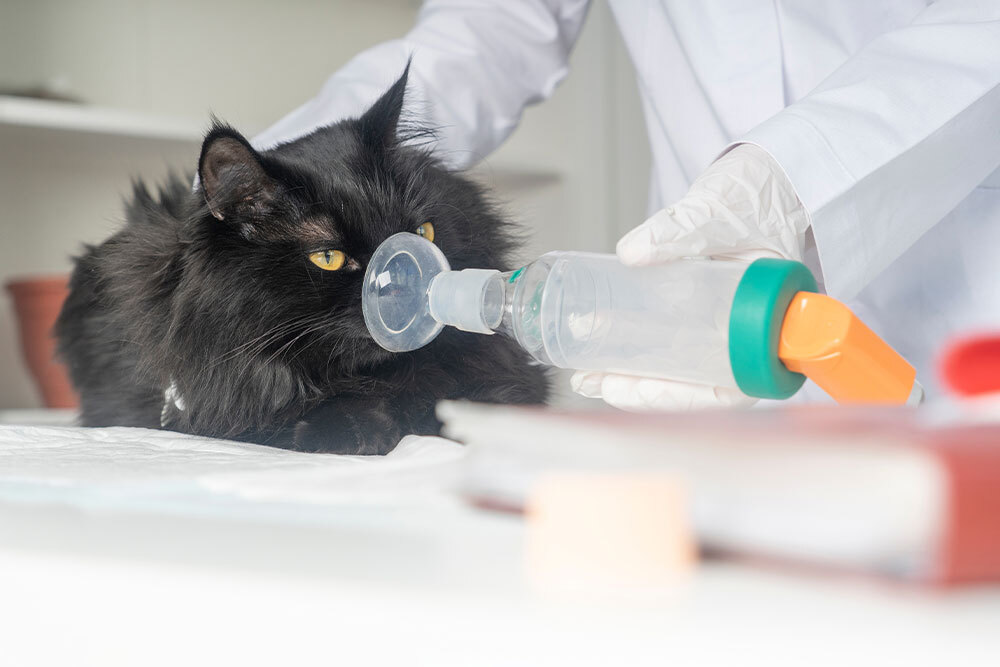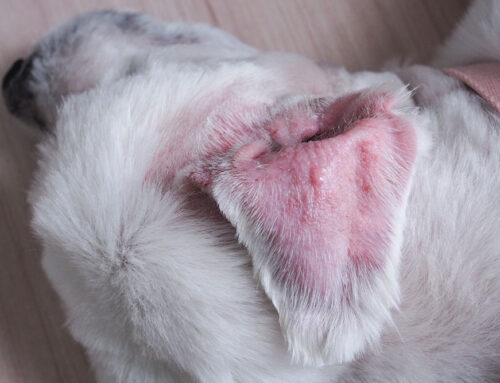Feline Asthma 101: How to Spot and Manage Your Cat’s Cough
It’s not unusual to hear a cat cough every now and then—maybe after a thorough grooming session or a playful tussle with a dust bunny under the couch. But when the coughing becomes frequent, or you start noticing wheezing and labored breathing, it’s time to pay closer attention.
At Valley Center Veterinary Clinic, we often guide concerned pet owners through their first experience with feline asthma- it can be scary! The good news? With attentive management, most cats with asthma live full, comfortable lives.
What Is Feline Asthma?
Feline asthma is a chronic inflammatory condition that narrows the airways in your cat’s lungs. Much like human asthma, it causes coughing, wheezing, and difficulty breathing. The inflammation leads to excessive mucus production and tight muscles around the airways, making breathing labored. Unlike upper respiratory infections, asthma is not caused by infection and is not contagious. However, inflammation triggered by allergens makes it a chronic condition requiring careful control.
Common Causes and Triggers
Asthma in cats often begins when indoor pollution or allergens irritate their airways:
- Household dust mites, pollen, or mold spores
- Smoke from cigarettes, fireplaces, or candles
- Cleaning agents, perfumes, and aerosol sprays
- Strong air fresheners and scented candles
- Industrial household chemicals or even dust from litter
Certain breeds, like Siamese and Himalayan cats, may be genetically predisposed, and obesity often worsens respiratory symptoms.
Why Asthma Deserves Attention
When left untreated, asthma can progress from mild, occasional coughing to life-threatening respiratory distress. Chronic inflammation may cause irreversible airway damage. Early diagnosis and treatment are key to minimizing flare-ups and preventing permanent lung changes. Want to learn even more about asthma? Check out this guide from International Cat Care.
How to Recognize Asthma in Your Cat
Cats are masters at masking illness, so detecting asthma often requires observant owners and a bit of detective work:
- Chronic coughing or wheezing, often misread as hairballs
- Rapid or labored breathing (tachypnea or dyspnea)
- Open-mouth breathing, which is a serious warning sign
- Hunched posture with an extended neck or chest, trying to catch a breath
- Limited energy or play, with reluctance to move
- Vomiting during coughing episodes
- General lethargy or poor appetite
Symptoms tend to occur in sudden, intense bouts. Between attacks, your cat may appear entirely normal.
What Happens if Asthma Goes Untreated?
Untreated asthma can cause significant and irreversible damage to your cat’s lungs:
- Chronic inflammation leads to scarring (fibrosis)
- Mucus buildup increases the risk of infection
- Over time, airways become rigid, reducing responsiveness to medication
- Severe asthma may progress to respiratory failure
To prevent complications, controlling inflammation before permanent damage occurs is essential.
Diagnosing Feline Asthma: What to Expect
At Valley Center Veterinary Clinic, we follow a thorough, stepwise approach:
- Physical examination and lung auscultation—listening for wheezes or crackles
- Chest X-rays—isolates airway narrowing, lung hyperinflation, or fluid buildup
- Blood tests—rule out infection, heart disease, or systemic conditions
- Advanced procedures like bronchoscopy or bronchoalveolar lavage (BAL)—cells and fluid are sampled directly from the airways
- Diagnostic screenings—depending on your cat’s risk factors, we may test for parasites or heartworm
Being thorough ensures we rule out look-alike conditions and accurately diagnose asthma. Read more about what to expect from Cornell’s Feline Health Center.
Treatment: How We Help Cats Breathe Easier
Treatment aims to reduce inflammation, open airways, and prevent future flare-ups.
Common Treatments Include:
- Corticosteroids—oral or injectable steroids to control inflammation
- Bronchodilators—short-term relief by relaxing airway muscles
- Inhalers like the AeroKat—a feline-adapted spacer delivers medication directly where it’s needed
- Environment control—reducing allergens by using air purifiers, unscented products, and regular dusting
- Acute care—hospitalization, oxygen, and anti-inflammatory medications during severe flare-ups
- Maintenance therapy—continued use of inhalers or low-dose steroids during stable periods
Life at Home with an Asthmatic Cat
Understanding and modifying your home can make daily life easier:
- Use dehumidifiers and HEPA air filters
- Switch to unscented or gentle cleaners; avoid perfumes
- Wash bedding weekly and vacuum with a HEPA filter
- Keep an eye on resting respiratory rates (20–30 breaths per minute for cats)
- Log flare-ups to identify triggers
These measures, combined with prescription therapy, greatly reduce episode frequency.
Complications, Variants, and Differential Diagnoses
Even well-managed asthma may present challenges:
- Brittle asthma—severe cases requiring specialized inhalation therapy or combination treatment
- Acute emergencies may involve pneumothorax (collapsed lung), requiring immediate care
- Conditions like lung parasites, heart disease, or lung tumors may mimic asthma—hence the need for thorough diagnostic work
Because similar clinical presentations can have vastly different underlying causes, correct diagnosis is essential.
Responding to a Serious Attack
If you see any of the following emergency signs, seek immediate veterinary care:
- Open-mouth breathing or panting
- Collapse or ‘respiratory distress’—covered in the AAHA guide on Respiratory Distress in Pets
- Gums turning blue or pale
- Weakness or sudden disorientation
- Unsuccessful coughing fits or rapid progression of symptoms
These signs indicate a life-threatening situation.
FAQs About Feline Asthma
Q: Is asthma the same as bronchitis?
A: Asthma involves reversible airway constriction due to inflammation, while bronchitis is usually chronic inflammation of the airways. Symptoms may overlap.
Q: Can cats use inhalers effectively?
A: Yes—using tools like the AeroKat spacer often makes inhalers well-tolerated and very effective.
Q: Is asthma contagious?
A: No—unlike respiratory infections, asthma is not transmissible. It’s typically a reaction to allergens or environmental irritants.
Q: Will my cat need episodic emergency visits?
A: Some cats require hospitalization during severe flare-ups. Most manage well with stable maintenance and environmental care.
We’re Here to Help
Feline asthma doesn’t have to define your cat’s life—it just needs attentiveness, routine, and care. At Valley Center Veterinary Clinic, we’re dedicated to helping you and your feline friend breathe easier. If you suspect asthma or have questions about your cat’s respiratory health, book an appointment today. Together, we’ll build a personalized management plan to keep your cat calm, resourceful, and healthy for years to come.








Leave A Comment